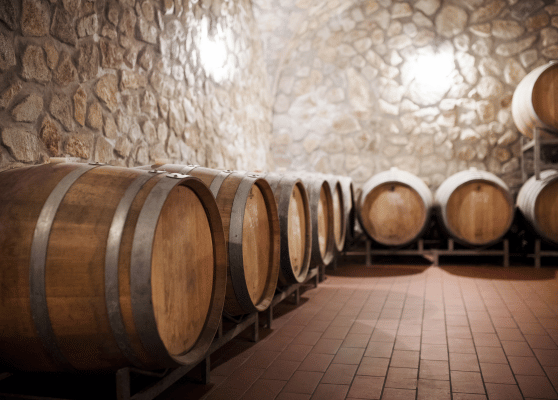Barrel care & service life – How to keep a wooden barrel in top form for a long time
A high-quality wooden barrel is a valuable investment for winegrowers, but its lifespan and the quality of the wine stored in it depend largely on proper care. While barrique barrels are only used intensively for a few years, storage barrels can remain in use for decades – provided they are cleaned, cared for and stored properly. Neglected barrels, on the other hand, can quickly become hotbeds of bacteria, develop leaks or transfer undesirable aromas to the wine. In this article, we show what is important when it comes to barrel care and how winemakers can extend the life of their wooden barrels.

Why is proper barrel care so important?
A wine barrel is much more than just a storage container – it influences the aromas, tannins, and structure of the wine. Through the fine pores of the wood, slow micro-oxidation takes place, contributing to the aging process. At the same time, however, bacteria, yeast, or mold can settle in the pores if the barrel is not cleaned regularly.
Proper care ensures that:
✔ The wine remains hygienic and flawless – no off-flavors or wine faults occur.
✔ The wood retains its optimal function – no cracks, mold growth, or flavor defects arise.
✔ The lifespan of the barrel is extended – with regular cleaning and maintenance, storage barrels can be used for decades.

Cleaning & Disinfection – How to Keep the Barrel Hygienic
The gentlest yet effective method for cleaning wooden barrels is cold water. It thoroughly removes residues without damaging the wood’s structure. We recommend cleaning the barrel immediately after emptying it using clear, cold water and a brush. For barrique barrels, there are also special high-pressure cleaner attachments that gently clean the barrels. If the barrel is then stored empty, it should be preserved with sulfur. Sulfuring protects against microbial contamination and maintains the sensory integrity of the wood – ensuring the barrel can fully develop its aging potential when used again.Preservation of Wooden Barrels
To store an empty barrel hygienically over a longer period, preservation is essential. Two proven methods are commonly used:- Sulfuring with sulfur sticks:
Sulfur sticks are ignited on a wire hanger inside the barrel, and the lid is sealed airtight. The resulting sulfur dioxide solution acts as a germ inhibitor and reliably protects the wood. Important: re-sulfur regularly (approx. every 6–8 weeks). - Sulfur solution with citric acid:
A solution made from sulfurous acid (or potassium metabisulfite) and citric acid is poured into the barrel. It forms a stable protective solution that preserves the interior of the barrel.
| Cleaning Method | Advantages | Application Area |
|---|---|---|
| Cold water and brushing | Simple and natural method, reliably removes normal dirt. | Basic cleaning after each emptying. |
| Steam cleaning | Penetrates deep into wood pores, reliably kills germs. | For thorough disinfection without chemicals. |
| Sulfuring | Fights bacteria and mold, preserves the barrel. | For disinfecting empty barrels. |
| Ozone treatment | Germ-free cleaning without chemical residues. | For the highest hygiene standards. |
Storage & Drying – How to Keep the Wood in Perfect Condition
A wooden barrel should never dry out completely, as the wood can become brittle and develop leaks. Especially during long-term storage or between two fillings, it’s important to treat the barrel correctly:
✔ Storage with residual moisture – A slightly moist barrel remains stable and leakproof. If not used for an extended period, it must be preserved.
✔ Ideal room climate – Storage conditions should remain constant: temperature between 10–15°C, humidity between 75–85% to keep the wood supple.
✔ Too dry cellar – If the cellar is too dry, the barrel must be rinsed regularly with fresh water and freshly sulfured or preserved wet.
Repairs & Retreatment – When the Barrel Ages
Even well-maintained barrels show signs of wear over time. But not every barrel needs to be replaced right away – small damages can often be repaired, or the barrel can be enhanced through retreatment.
When is barrel restoration worthwhile?
- Replacing staves – If individual wooden parts become leaky, they can be replaced.
- Re-toasting – Some barrels can be revitalized by re-toasting the interior to refresh their aromas.
- Repairing hoops – Metal hoops can be replaced or tightened if they become loose.
When is a barrel no longer usable?
Even the best wooden barrel eventually reaches the end of its life. Typical signs include:
❌ Deep cracks or leaks that can no longer be repaired.
❌ Mold or heavy contamination that cannot be removed despite cleaning.
❌ Completely leached wood that no longer affects the wine.
But even if a barrel can no longer be used for wine storage, there are many creative secondary uses: Old barrels are often turned into furniture, flower pots, decorations, or even whisky barrels.
Conclusion – Proper Care Makes the Difference
A wooden barrel is a long-term investment that can be used for years or even decades with the right care. Regular cleaning, proper storage, and occasional small repairs help to preserve the quality of the wood and therefore the wine. While barrique barrels lose their aromatic impact after a few years and need to be replaced, storage barrels can be used for generations – provided they are properly maintained.
The art of barrel care is a combination of tradition, experience, and modern technology. Those who find the right balance between hygiene, storage conditions, and retreatment ensure that every barrel contributes to the perfect aging of wines for many years to come.
